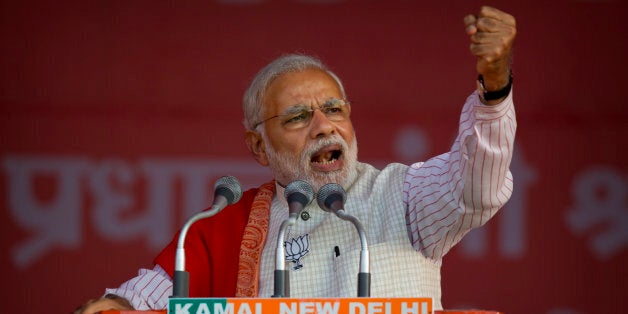
This piece was co-authored by Mohan Guruswamy, former Secretary of Finance in the Government of India.
The people of Delhi, who strongly supported Narendra Modi by electing all seven of his Bharatiya Janata Party (BJP) candidates in last year's parliamentary election, delivered him a stunning rebuke in the state elections. The BJP was able to win only three seats in the 70-member Delhi Assembly, while the supposedly underfunded Aam Aadmi Party (AAP) won an astonishing 67 seats.
While much bloviating is going on about the AAP's diligent grassroots campaigning, and the BJP's lazy arrogance, what happened in Delhi -- India's capital -- was that the lesson of history was being administered: Indian can only be governed by the consent of not just the majority but also all its diverse peoples.
India has more than 1.2 billion people, dispersed across 29 States and seven Union Territories. The biggest of these is Uttar Pradesh with a population of 199.6 million or 16.49 percent of India's total. It is as big as Brazil. The smallest political unit is Lakshadweep which has just 64,000 (0.01 percent). Quite clearly, the omnibus term India, incidentally derived from the name of a river -- Indus -- that hardly flows through it, masks a diversity of nations. It is complex, vast and heterogeneous. Modern India now has more than 2,000 ethnic groups. Modern Indian languages have evolved from all the world's four language families: Indo-European, Dravidian, Austro-Asiatic and Tibeto-Burman. India has 1,652 individual mother tongues. The 2001 Census tells us that 30 languages are spoken by over a million people each, and 122 by over 10,000 each.
For most of its history India was a civilizational notion with many entities; there were few times it has been welded together under a central authority.
Great rulers such as Ashoka and Akbar who achieved it did so more by reconciling the competing aspirations of kings and princes who held sway over swathes of territory, mostly by the exercise of imperial authority and often by displaying benignity after the use of arms.
Even the British, who created the largest imperial India ever, ruled it by incorporating various principalities and nationalities less by force of arms but more by persuasive subterfuge; they rarely had to take off the velvet glove to display the iron fist. Even in the heydays of the Raj, a few hundred Britons, with the co-operation of the native elite, governed India.
Rulers such as Aurangzeb, the last great Moghul emperor, and even democratically elected Indira Gandhi who tried to impose their beliefs and will by force, were felled by regional uprisings and the breakdown of the system of authority. This, then, is the great lesson of history. India can only be governed and kept together by the persuasive use of authority and not by force. The government, particularly an elected one, can only govern not just with the support of a majority in parliament, and by a few groups who can make up an electoral majority, but by catering to the aspirations and demands of the tiles of the colorful mosaic India is.
Only a system that seeks to reconcile the often competing demands and aspirations of its millions can work.
That's why India's founding fathers wrote a great Constitution, hugely inspired by the American Constitution, with its bedrock of individual freedoms and promise of hearing every voice and seeking to meet every aspiration, in some measure.
This system has prevailed in India since 1950, when its Constitution was passed by the Constituent Assembly. Since then democracy has flourished in India. All the rights, particularly those relating to equality of races, groups and gender, were assured by the Constitution of India, much before they became a reality in the United States.
In recent times, after the advent of the BJP government led by the charismatic Mr. Modi, powerful voices from within the BJP and its parent, the secretive Rashtriya Swayamsevak Sangh (RSS), have been openly espousing Hindutva.
Hindutva, in their lexicon, is an ideology that selectively chooses from India's complex past to advance an agenda. This seeks to impose the primacy of Hindu thought, philosophy and folklore now often confused with history.
While Mahatma Gandhi, himself a devout Hindu, sought the reformation of Hindu society by ending its institutional inequity, protagonists of Hindutva seek a revival. India's founding fathers envisaged a syncretic nation with a fusion of culture that treated all the periods of India's past as its own, making the Taj Mahal at Agra as uniquely Indian as the Meenakshi temple at Madurai. Elements of the BJP/RSS have opened many fronts. Some have begun a program to return India's Christians, mostly drawn from lower caste and tribal groups considered less than equal by Hindu traditionalists, to the Hindu fold. Some others have attacked India's huge Muslim minority of more than 200 million people waging a "love jihad" so that Muslim youth marry more Hindu girls.
These zealots raise fears of a faster growing Muslim population who might many centuries later swamp the Hindus. True the population growth among Muslims is higher than the norm, but it is not less than that of lower caste Hindus, suggesting that poverty and backwardness have more to do with it than theology.
But such arguments are dismissed as secularist talk, derisively referred to as "sickular." The spread of Saudi-funded teaching institutions espousing a radical Islam, to supplant the Sufi traditions of most Indian Muslims, adds more edge to this.
Both the BJP and the AAP need to keep this in mind: It's dangerous to play with history; it's still more dangerous not to learn from it.
